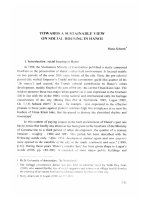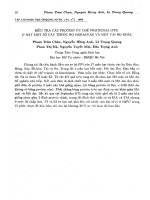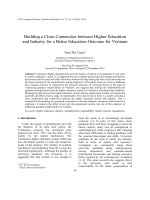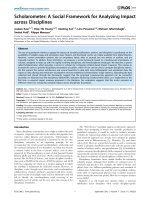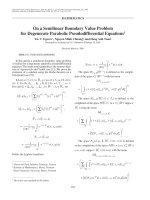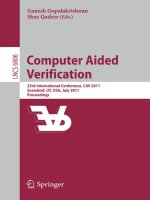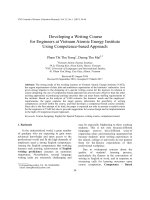DSpace at VNU: Building a Close Connection between Higher Education and Industry for a Better Education Outcome for Vietnam
Bạn đang xem bản rút gọn của tài liệu. Xem và tải ngay bản đầy đủ của tài liệu tại đây (180.27 KB, 8 trang )
VNU Journal of Science: Education Research, Vol. 32, No. 4 (2016) 36-43
Building a Close Connection between Higher Education
and Industry for a Better Education Outcome for Vietnam
Tran Thi Tuyet*
Institute for Employment Research,
German Federal Employment Agency
Received 05 August 2016
Revised 10 September 2016; Accepted 22 December 2016
Abstract: Vietnamese higher education has received massive criticism as its graduates do not seem
to satisfy employers’ needs. It is suggested that the outdated professional knowledge provided by
universities and the poor soft skills university students develop during the time at the university are
the direct reasons for the unsatisfaction among employers. This paper, however, aims to challenge
this common criticism. It summarises the research outcomes of a doctoral thesis on the topic of
“enhancing graduate employability in Vietnam” and suggests that shifting the responsibility for
graduate unemployment onto the higher education system in Vietnam is convenient but simplistic.
Bridging the gap between the higher education system and the employment market will require the
goodwill and efforts from a range of stakeholders. First and foremost, there is a need to develop a
close cooperation and connection between the higher education system and industry. This is
essential for the building of a practical curriculum to develop students’ enterprise skills desired by
employers. It requires the effort of not only the educational system, but also of the employer in
enhancing graduate employability in Vietnam.
Keywords: Higher education, industry, unemployment, responsibility, human resource management.
1. Introduction *
meet the needs of an increasingly developed
economy [1]. In spite of that claim, many
graduates have still been struggling to enter the
labour market, many end up unemployed or
underemployed, while employers still complain
about their difficulties in finding graduates with
the required knowledge and skills. University
graduates do not seem to satisfy the industry,
both in terms of quality and “quantity”.
Complaints are consistently made about
university graduates being underprepared,
having impractical and underdeveloped
professional knowledge and lacking necessary
skills required by the contemporary workplace
[1- 4]. This same research also suggests that it
is the university who needs to take
responsibility for the under- preparedness of
Under the impact of globalization and with
the adoption of an open door policy, the
Vietnamese economy has developed quite
impressively since 1987 and has been driven
mainly by the market mechanism. The
Vietnamese higher education system (HES) has
also developed quickly to meet the manpower
needs of the industry. The number of students
enrolling in and graduating from the system has
increased significantly. Although the number of
university graduates has increased, it is
suggested that that number is not enough to
_______
*
Tel.: 49-15218164268
Email:
36
T.T. Tuyet / VNU Journal of Science: Education Research, Vol. 32, No. 4 (2016) 36-43
their students, and who needs to change to
address the new needs of the contemporary
labour market.
Nonetheless closely investigating the
current situation of the training in universities
and the human resource management of
Vietnamese enterprises, this article wants to
address a broader picture and take into account
related issues and suggests that enhancing
graduate employability needs more than the
hand of the HES. In the case of the Vietnamese
market, a practical collaboration between higher
education institutions and enterprises seem to
be a way to develop sustainable high skilled
labour resource for the local market.
2. Is the HES able to change and can it take
the sole responsibility for the underpreparedness of recent graduates?
Unlike universities in most developed
countries who traditionally have two major
functions: “to prepare the elite to govern the
nation” and “to provide an institutional basis for
research into all forms of knowledge” [5], the
main mission of Vietnamese higher education
has been to prepare students for work and to
supply skilled workforce for the development
of the country [6, 7]. In Vietnam, traditionally
there is a view that training and development
are not the employers” responsibility but is
instead, the responsibility of the government
and the educational system [8]. Thus, employers
often choose to “stay away” from the training
process in universities, and blame the weak
capability of recent graduates on higher education.
Nonetheless, Vietnamese higher education that is
under tight control in a centralized educational
system is still struggling to find ways to improve
the training quality and to address the new needs
of the contemporary market.
Moreover, the traditional mission of
universities in Vietnam was to prepare workers
for a command economy, where workers were
required to follow orders, to listen and obey,
rather than develop creativity and take initiative
37
[9]. Thus, the teaching at higher education has
been strongly reflected both Confucian culture
and the old Soviet system top-down approach
where the teacher is considered the primary
source of knowledge. The main duty of students
from primary school to university has been
receiving knowledge from the teacher and then
re-learning it for the exam.
However, after the implementation of the
open door policy, with the massive
development of both private and Foreign direct
investment (FDI) sectors which offer much
higher wages, the traditional “products” of the
Vietnamese HES, the passive learners and
workers, do not appear to be suitable for work
in these sectors. As Vietnam has integrated
more and more into the global market with its
becoming a member of Association of
Southeast Asian Nations (ASEAN) in 1995 and
the World Trade Organization (WTO) in 2007,
the internal economy has also needed to change
to response to the international competitive
market. Instead of requiring loyalty, hard-work
and obedience as in the centrally planned
economy, employers now require graduates to
understand a foreign language, especially
English, to have good communication skills,
teamwork and personal skills and obtain such
characteristics as taking initiative and being
proactive [2, 7, 10].
The HES has been struggling under the
pressure to develop a system that meets the new
needs of the economy. However, universities
have to face many challenges in the transitional
period: they lack teaching staff [11], lack
funding and resources [12], they even lack the
right to decide their own matters such as
developing their own curriculum framework or
1
designate their own rector [13, 14]. In addition,
the inherited infrastructure of most universities
is out-dated and the teaching methods in the
system have remained quite traditional -
_______
1
Vietnamese HES is still under centralized governance, where
the central ministry (the Ministry of Education and Training)
decides the most decisive matters such as curriculum
framework or governance matters in every institution.
38
T.T. Tuyet / VNU Journal of Science: Education Research, Vol. 32, No. 4 (2016) 36-43
transmitting knowledge from the teacher to the
student. These all require time, support, funding
and effort to change to address the new labour
needs of the economy. Adding to these
difficulties and challenges are the loose
relationship between the HES and the labour
market. The weak research capability of
universities and the weak research-industry
linkages have placed more hurdles for
universities in enhancing graduate capability for
employment [15]. Although Vietnamese higher
education has started to be aware of the new
needs of the labour market, it does not seem to
be able to change to address these needs in the
short term.
Moreover, both the employment market and
Vietnamese higher education are in the
transitional phases of the economy, from the
centrally planned to the market driven
economy. In that transitional period, the poor
communication and the lack of understanding
between the two create more frustration for
recent graduates, who come out from the HES
and seek the way to enter the employment
market [4, 15]. These young people who
receive virtually no formal training and no
information about the employment market
during their university time [16], are wobbling
around to find ways to enter the labour force.
Standing in front of one of the most important
transitions in life, students (without the
guidance from universities) become bombarded
with rumours coming from different directions
in the Vietnamese collectivist culture where
communication is often “indirect, implicit,
internalised, or more dependent on physical and
psychosocial contexts” [17]. Stories of
corruption, of luck, of the poor employability
assets they possess together with the desire to
keep face for the whole family, to earn money
right after graduation and to find work and stay
in the big cities add much more nervousness for
recent graduates when struggling to find their
ways entering employment [18]. The
underemployment and unemployment of recent
graduates does not seem be the result of only
the poor quality of training in higher education.
3. Human resource issues in Vietnamese
enterprises
Human resource management practices
seem to be a critical issue in Vietnam where
employers are often considered to lack
management skills and the knowledge to
conduct their business properly [8]. Not all SME
owners and employers have relevant higher
education qualifications, and their managerial
expertise is mainly based on practical knowledge
acquired over time [15, 19].
When the majority of Vietnamese
companies are small and medium-sized, where
the owners often keep a close eye on costcutting policies, the funding of human resource
management activities is often very limited. In
Vietnam, local organisations are often weak in
developing company-specific skills and
knowledge, and are likely to outsource their
training [8]. Formal qualifications are
considered important for job seekers entering
these sectors. By contrast, in international
enterprises, there is evidence of more modern
human resource management practices.
Compared to local enterprises, international
enterprises are more active in finding applicants
for open positions, developing their human
resource assets more by in-house facilities than
by outsourcing, appraising people more on an
individual basis, and rewarding them more
generously with respect to their level of
performance [8, p. 40].
Compared to the FDI enterprises, the
working conditions as well as the wages offered
by local enterprises tend to be significant,
making them less attractive to the most suitable
candidates in the market. Even when this is the
case, the blame easily returns to the HES:
“although enterprises have too many
applications from university graduates for each
vacant position, it is still not easy for them to
find the one suitable” [19, p.31].
Clearly, there are many challenges for
Vietnam during this intense transitional period,
where the economy is rapidly changing. As a
result of the limited funding for, and limited
T.T. Tuyet / VNU Journal of Science: Education Research, Vol. 32, No. 4 (2016) 36-43
understanding of contemporary human resource
practices, together with the widespread
assumption that training for work is still
considered the responsibility of the government
and the educational system, it seems unlikely
that Vietnamese local enterprises will attain the
desired workforce quickly. In stark contrast,
international
enterprises
generally
use
transparent employment processes including
developing and supporting their staff with inhouse training, attractive salaries, and reward
systems to acknowledge the performance of
their employees. It is these organisations that
the most skilful and productive workers,
understandably, want to join. These are also the
reasons why international organisations often
attract and reach more qualified candidates in
the labour market. This creates a fear among
local organisations that they will lose their welltrained and highly qualified employees for a
better paid job in FDI enterprises [20]. The
“brain drain” from local to more global
organisations is happening extensively and
rapidly
within
the
local
Vietnamese
employment market. The urgent call for change
by local companies does not yet appear to have
been heeded. It is suggested that they should
invest more in their human resource
management policies and practices, and
cooperate with the higher education sector [8,
19, 21]. However, this is more easily said than
done as great cultural change is required within
the workplace.
4. A broad picture of graduate employability
in the literature
In the international context, there is much
research investigating into the gap between
higher education and the employment market. It
is widely suggested that recent graduates
generally lack the skills the contemporary
market requires. Such interactive attributes as
communication
skills,
teamwork
and
interpersonal skills together with personal
attributes and abilities such as intellect,
knowledge, willingness and ability to learn and
39
continue learning are highly valuated by
employers [22-24]. Some researchers are still
working hard to build a list of attributes
contemporary employers need from university
graduates [See, for example 25, 26, 27, 28]. In
Vietnam, several such a list have also been built
[See, for example 10, 29]. Nonetheless, a recent
study conducted by Tran Thi Tuyet [30] reveals
that employers in Vietnam may require some
types of different skills when they emphasise on
the ability of recruits to understand and to work
well in a collectivist culture. The findings of
Tran Thi Tuyet”s study also support a popular
claim that skills are not context and culture free
[31-33], and that “the worth of employability
skills can only be fully appreciated in the
workplace where the consequences of such
skills can be seen” [34, p.11]. In Tran Thi
Tuyet”s [30] study, Vietnamese employers
often want to find new employees who have
some enterprise skills, who has been involved
in some types of similar work, or in other
words, they look for some type of work
experience.
5. Connecting enterprises and graduate
employability
The Vietnamese government has also
recognised the mismatch between higher
education training and the employment market.
It has been stipulated in numerous documents,
policies, plans and resolutions the aim to
increase the training quality in universities and
to reinforce the central mission of higher
education which is to provide high skilled
workforce for the development of the country.
Nonetheless, many of these resolutions and
plans have been criticised as impractical as they
were issued without careful research into the
background context, culture, as well as teaching
and learning infrastructure, condition, traditions
and habits in Vietnam. These together with
unclear implementing steps in most cases have
led unsurprisingly to an unsuccessful result [35,
36]. The current situation of the HES in
Vietnam and the gap between education and the
40
T.T. Tuyet / VNU Journal of Science: Education Research, Vol. 32, No. 4 (2016) 36-43
real needs of the society in terms of university
graduates in particular, call for the collaboration
between the universities and employers to close
the gap and to increase the employability
among recent graduates.
It is suggested that not only universities, but
also employers need to make greater efforts to
bridge the divide between higher education and
the labour market. Employers often place high
requirements on recent graduates and complain
about the poor knowledge and skills graduates
possessed. However, employer requirements
and complaints about the required skills of
recent graduates are not entirely reasonable. As
skills need to be developed in real practice,
recent graduates need time and guidance to
transform what they possess from study and
apply it to work. Gradually, work related skills
should develop [34]. Employers should also
take some responsibility for helping students
and graduates make the transition from
university
to
work.
The
demanding
requirements of employers on recent graduates
when recruiting them often create a pressure for
graduates who often measure their capability
according to the job requirements in the market.
When they do not have good professional
knowledge, when they do not have many
chances to develop necessary skills, when their
English is still not perfect and when they do not
have any work experience, they do not feel
confident to enter the employment market. This
often creates a desire to learn more, to collect
enough certificates to prove that they are
qualified. However, students” and graduates”
learning of “what” rather than learning of
“how” often disappoint employers.
Clearly, employers should take greater
responsibility
for
enhancing
graduate
employability for university students because
they benefit from it. Universities cannot “bring
the market” into their curriculum and shorten
the learning curve in the transition from
university to employment for their students if
employers do not cooperate and participate.
Literature suggests different ways to
enhance graduate employability; nonetheless
the majority of which require the input and
collaboration of universities and enterprises.
This come from the call to develop a market
oriented curriculum, to create various types of
extra activities, and to bring more practical
lessons to help students familiar with the world
of work. Different names have been used to call
this
collaboration:
university-enterprise
collaboration, university-industry interaction,
university-business cooperation or businessuniversity collaboration. Numerous studies
discuss the benefits of this collaboration and
support the practical initiatives such as problem
based learning, work based learning,
placements, internships, enterprise learning…
[37]. Work integrated learning (WIL) is the
term most popular used to refer to the
cooperation between university and industry
aiming at enhancing graduate employability.
For some, WIL refers to all initiatives and
practices that connect theory to practice.
Cooper, Orrell and Bowden [38, p. Viii], for
example, defines WIL as “the process of
bringing together formal learning and
productive work, or theory and practice”. Some
other authors bring more specific definitions of
WIL. Ferns, Campbell and Zegwaad [39, p. 2],
for example, consider WIL experiences as
“authentically engaged with practices and
experiences of the workplace”. Similarly, WIL
is used to refer to, according to the Council in
Higher Education [40], an experience where
students are exposed to authentic and relevant
context at workplace where they can apply
theory to practice. With these definitions, WIL
refers to the experiential parts of the learning
process where students are exposed to the real
context of work to learn and to reflect on their
learning. Most often this type of WIL marks the
initiative from universities, aiming at bringing
practices from the world of work into their
curriculum. There is another type of WIL that is
not covered by the above definition, that is the
employer engagement in the university
practices. While work placements and
internships, work-based learning or service
learning recognize the role of the university in
sending their students from academic context to
the real context of work, employer engagement,
T.T. Tuyet / VNU Journal of Science: Education Research, Vol. 32, No. 4 (2016) 36-43
on the other hand, emphasizes the move of the
employer from the context of work to an
academic setting at university. These two ways
movements are sometimes blurry and
overlapping, however, employer engagement
does mark the effort of the employers when
they have to shift their role from their familiar
context of work to the formal academic context
at university. Such initiatives as employer
involvement in curriculum design, course design,
development and implementation, employer
getting involved in the director board, in delivery
of guest lectures… do create practical practices
within university setting and help to increase the
responsiveness of university.
There is strong history of sharing good
practices in the leading countries in graduate
employability activities such as UK, US,
Canada, Australia and other European
countries. Initiatives are numerous and vary,
and have been developed in specific
disciplinary, social and institutional contexts. In
Vietnam, the term “WIL” is still rather new;
nonetheless, evidences of its presence start can
be found in the system. There is growing
number of evidences for the collaboration
between universities and enterprises. Apart
from sending students to enterprises for visits
(kiến tập) or internships (thực tập) (compulsory
part of the traditional HE curriculum in
Vietnam), some universities also invite
employers to deliver guess lectures, to join
seminars or to share employment experience
with students. The work fairs with the presence
of employers in different universities to employ
students and graduates are also organized more
frequently. Employers start receiving surveys
from universities asking them to evaluate the
curriculum or the quality of universities”
students or graduates who work for them.
Nonetheless, the impact of these WIL
initiatives in Vietnam is still considered modest,
and it seems to be hard to develop a strong and
sustainable UEC for enhancing graduate
employability. Interestingly, universities often
complain that the active involvement of
employers in the collaborations with
universities is rare. Apart from approaching
41
universities for recruitment of graduates, for
scholarships sponsoring, sometimes for
sponsoring students extra curriculum activities
and advertising their company images or
products, not many enterprises actively
approach universities to discuss about the
collaboration in teaching or training (either for
their staff or for university students) or for
research collaboration [41]. However, when it
comes to the employers” view, there seems to
be another picture drawn about the
collaboration
between
universities
and
enterprises. There is, although limited, but
growing number of employers, who understand
the importance of their input from the early
stage of skill development and are open for
collaboration with universities for human
resource training. These employers also raise
their voices complaining about their difficulties
in communication with universities and in
understanding universities” goal when students
are sent to their organizations for internships or
placements [42].
The development of collaboration between
universities and enterprises to enhance graduate
employability in Vietnam seems to be at an
early stage. Efforts have been brought in,
nonetheless, the lack of mutual understanding,
the scarcity of resources and the lack of
sufficient communication all seem to interfere
and hinder the UEC effort to better prepare
students for the employment market.
There is a need to provide support for
successfully implement the UEC in Vietnam.
Research on obstacles in setting up UEC should
be invested in order to better approach the
problems;
and
cases
of
successful
collaborations between universities and
enterprises should be developed and expanded
in the system. It is necessary for both
universities and enterprises to see their roles
and their benefits in the collaboration, then
actively find a way/ways to develop
collaboration that works in the specific
context/circumstance of their organizations.
Moreover, in the early stage of UEC
development,
the
role
of
the
government/MOET should be decisive. In a
42
T.T. Tuyet / VNU Journal of Science: Education Research, Vol. 32, No. 4 (2016) 36-43
centralised educational system, if the
government agrees to provide incentives both
for enterprises (i.e. tax reduction and other
enterprise benefits) and for universities (i.e.,
human resource and funding), the collaboration
will provide clear initial and on-going benefits
for all related stakeholders. When universities
and enterprises communicate well with each
other, when WIL initiatives are authentic,
students will gain benefits from receiving more
practical lessons and thus, prepare better for the
demanding requirements of employers when
joining the labour market after graduation.
[10]
[11]
[12]
References
[1] The World Bank. (2008). Vietnam: Higher
education and skills for growth (pp. 195). Hanoi:
Human Development Department East Asia and
Pacific Region.
[2] Ketels, C., Nguyen Dinh Cung, Nguyen Thi Tue
Anh, & Do Hong Hanh. (2010). Vietnam
competitiveness report. Hanoi: Central Institute
for Economic Management.
[3] Montague, A. (2013). Vocational and skill
shortages in Vietnamese manufacturing and
service sectors, and some plausible solutions.
Asia Pacific Journal of Human Resources, 51(2),
208-227.
[4] Pham Thi Huyen. (2008). Higher education in
Vietnam: A look from labour market angle.
Hanoi: Vietnam Development Forum.
[5] Jarvis, P. (2002). The changing university:
Meeting a need and needing to change. Higher
Education Quarterly, 54(1), 43-67.
[6] George, E. S. (2010). Higher education in
Vietnam 1986-1998: Education in transition to a
new era? In G. Harman, M. Hayden & Pham
Thanh Nghi (Eds.), Reforming higher education
in Vietnam (pp. 31-50). London: Springer.
[7] Tran Ngoc Ca. (2006). Universities as drivers of
the urban economies in Asia: The case of
Vietnam. Policy Research Working Paper:
World Bank.
[8] Le Chien Thang, & Truong Quang. (2005).
Human resource management practices in a
transitional economy: A comparative study of
enterprise ownership forms in Vietnam. Asia
Pacific Business Review, 11(1), 25-47.
[9] Nguyen Van Lịch. (2009). Solutions for
diminishing the non market driven factors in
[13]
[14]
[15]
[16]
[17]
[18]
[19]
Vietnamese economy (Khắc phục yếu tố phi thị
trường trong nền kinh tế Việt Nam hiện nay).
Journal of Economic Management (Tạp chí
Quản Lý Kinh tế), 28(9/10), 13-20.
Tran Quang Trung, & Swierczek, F. W. (2009).
Skills development in higher education in
Vietnam. Asia Pacific Business Review, 15(4),
565-586.
General Statistics Office. (2012). Higher
education statistics. Retrieved 28 May, 2014,
from
/>idmid=3&ItemID=11406
Evans, K., & Rorris, A. (2010). Optimising the
impact of Vietnam”s higher education sector on
socio-economic development. In G. Harman, M.
Hayden & Pham Thanh Nghi (Eds.), Reforming
higher education in Vietnam: challenges and
priorities (pp. 167-182). London: Springer.
Hayden, M., & Lam Quang Thiep. (2010).
Vietnam”s higher education system. In G.
Harman, M. Hayden & Pham Thanh Nghi
(Eds.), Reforming higher education in Vietnam
(pp. 15-30). London: Springer.
The Southeast Asian Ministers of Education
Organization. (2007). Vietnam higher education
system.
Retrieved 03 April, 2014, from
/>com_content&task=view&id=32&Itemid=41
Fatseas, M. (2010). Research-Industry cooperation
supporting development in Vietnam: the challenge
of translating policy into practice. In G. Harman,
M. Hayden & Pham Thanh Nghi (Eds.), Reforming
higher education in Vietnam: Challenges and
priorities (pp. 103-116). London: Springer.
Mai Trong Nhuan, & Hoang Van Van. (2009).
Enhancing graduate employability at Vietnam
National University, Hanoi: A case study Sri
Lanka: University of Kelaniya.
Scheele, T. H., Pruitt, R., Johnson, A., & Xu, Y.
(2011). What do we know about educating Asian
ESL nursing students? A literature review.
Nursing Education Perspectives, 32(4), 244-249.
Tran Thi Tuyet. (2013a). Count the uncounted:
Rumors, corruption and luck in job seeking by
Vietnamese university graduates. Journal of
Asian Critical Education,2, 3 -12.
Trinh Thi Hoa Mai. (2008). Liên kết đào tạo
giữa nhà trường đại học với doanh nghiệp ở Việt
Nam
(Education
association
between
universities and enterprises in Vietnam). Journal
of Economy - Law, Vietnam National
University, Hanoi, 24(2008), 30-34.
T.T. Tuyet / VNU Journal of Science: Education Research, Vol. 32, No. 4 (2016) 36-43
[20] Truong Quang, & Ha Kim Dung. (1998). Human
resource development in state-owned enterprises
in Vietnam. Research and practice in human
resource management, 6(1), 85-103.
[21] Nguyen Phuong Anh, & Robinson, A. G. (2010).
Managing continuous improvement in Vietnam:
Unique challenges and approaches to overcome
them. Quality Management Journal, 17(2), 27-41.
[22] Baker, G., & Henson, D. (2010). Promoting
employability skills development in a researchintensive university. Education+ Training, 52(1),
62-75.
[23] Harvey, L. (2000). New realities: The
relationship between higher education and
employment.
Tertiary
Education
and
Management, 6, 3-17.
[24] Speight, S., Lackovic, N., & Cooker, L. (2013).
The contested curriculum: Academic learning
and employability in higher education. Tertiary
Education and Management, 19(2), 112-126.
[25] Casner-Lotto, J., & Barrington, L. (2006). Are they
really ready to work? Employers” perspectives on
the basic knowledge and applied skills of new
entrants to the 21st century US workforce.
Washington DC: The Conference Board, Inc.
[26] Cox, S., & King, D. (2006). Skill sets: An
approach to embed employability in course
design. Education and Training, 48(4), 262-274.
[27] Hart, P. D. (2008). How should colleges assess
and improve student learning? Employers”
views on the accountability challenge”
Association of American Colleges and
Universities Report. Washington, DC: Peter D.
Hart Research Associates, Inc.
[28] Omar, N. H., Manaf, A. A., Mohd, R. H.,
Kassim, A. C., & Aziz, K. A. (2012). Graduates”
employability skills based on current job
demand through electronic advertisement. Asian
Social Science, 8(9), p103.
[29] Truong Quang Duoc. (2006). Quality of business
graduates in Vietnamese institutions: Multiples
perspectives.
Journal
of
Management
Development, 26(7), 629-643.
[30] Tran Thi Tuyet. (2013b). Limitation on the
development of skills in higher education in
Vietnam. Higher Education, 65(5), 631-644.
[31] Beckett, D., & Mulcahy, D. (2006). Constructing
professionals” employ-abilities: Conditions for
accomplishment. In P. Hager & S. Holland (Eds.),
Graduate attributes, learning and employability.
Dordrecht, The Netherlands: Springer.
43
[32] Holland, S. (2006). Synthesis: A lifelong
learning framework for graduate attributes. In P.
Hager & S. Holland (Eds.), Graduate attributes,
learning and employability. Dordrecht, The
Netherlands: Springer.
[33] Lowden, K., Hall, S., Ellio, D. D., & Lewin, J.
(2011). Employers” perceptions of the
employability skills of new graduates. London:
Edge Foundation.
[34] Smith, E., & Comyn, P. (2003). The
Development of employability skills in novice
workers. Adelaide: National Centre for
Vocational Education Research.
[35] Hayden, M., & Lam Quang Thiep. (2007).
Institutional autonomy for higher education in
Vietnam. Higher Education Research and
Development, 26(1), 73-85.
[36] Tran Thi Tuyet. (2014). Governance in higher
education in Vietnam – a move toward
decentralization and its practical problems.
Journal of Asian Public Policy, 7(1), 71-82.
[37] O”Leary, S. (2013). Collaborations in higher
education with employers and their influence on
graduate employability: an institutional project.
Enhancing Learning in the Social Sciences, 5(1),
37-50.
[38] Cooper, L., Orrell, J., & Bowden, M. (2010).
Work integrated learning: A guide to effective
practice. New York: Routledge.
[39] Ferns, S., Campbell, M., & Zegwaad, K. (2014).
Work integrated learning. In S. Ferns (Ed.),
Work integrated learning in the curriculum (pp.
1-6). Milperra, N.S.W: Higher Education
Research and Development Society of
Australasia HERDSA.
[40] Council in Higher Education. (2011). Workintegrated learning: good practice guide. South
Africa: Pretoria.
[41] Huynh Ngoc Long. (2012). Đào tạo đáp ứng nhu
cầu thị trường lao động (Training for the
employment market). Paper presented at the Đào
tạo, nghiên cứu khoa học và chuyển giao công
nghệ gắn kết với nhu cầu doanh nghiệp
(Training, research and technology transfer vs
enterprise demands), Dong Nai, Vietnam.
[42] Pham Thi Ly. (2013). Quan điểm của doanh nghiệp
về hợp tác với các trường đại học ở Việt Nam
(Enterprises” perspective of the collaboration with
universities in Vietnam). Hanoi: POHE project,
Ministry of Education and Training.
